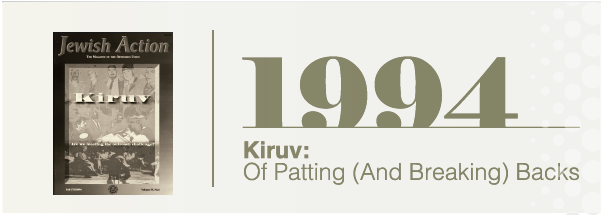1994—Kiruv: Of Patting (and Breaking) Backs
An anecdote resonates in my mind: Raphael Waldman, who had been a journalist at the Baltimore Sun before accepting Torah observance, described an early experience as a guest at an Orthodox home. He had been asked by his hosts, in the breathless and conspiratorial tones reserved for such forays, to describe the existential conditions of life outside the Pale. “I gave them what they wanted,” he concluded. “I told them that there was nothing out there!”
This small conceit of the insular crowd, the idea that outside of our little circle the world is a de-ideologized zone of corruption and permissiveness, generally seems a harmless enough foible. Its impact on the kiruv system has revealed a far more pernicious aspect.
The process of correcting our behavior, as practiced by us daily, is aptly called “teshuvah,” the Hebrew for “return.” Clearly, the place of goodness that we seek is one that we have known, even if only for fleeting instants in our lives. It is the space that we occupy when we are at our best, where our education and our identification mesh, where ideology embraces reality, where good will meets good deed. It is somewhere that we have been before and, more meaningfully, it is where we feel most natural.
Yet, we would deny to the new initiate that luxury. We too often insist on belittling, even negating, all the attainments which have characterized the earlier periods of their lives. The family life is hollow; the education shallow; the society degenerate; the relationships unhealthy; the character unformed; the views uninformed. Our new friends cannot “return” to that place in the soul unless we grant them access.
It is the view of my more sensitive colleagues that by this self-indulgent way of drumming home our exclusive custody of the moral high ground, we inflict undeserved damage upon our charges. If we pat ourselves on the back long enough, we eventually become spineless.
The people of the Western world, and more so the Jews among them, are fundamentally decent people, inculcated with most of the virtues of good character. Our job is to point out to our students those qualities which are best in their basic orientation and to build upon those foundations with the prescriptions, the wisdom and the values of the Torah serving as the enriching context.
When this is not done, a portion of our clientele gets lost, unable to face the stark test of self-negation we are imposing. Another portion stumbles over the line into commitment, but then sinks into a profound abyss. If he cannot take pride in his education and his career, if his family is only the instrument of betrayal that denied him his birthright, if his hobbies and interest were empty pastimes, if his friends were pulling him down, if his loves were illusions and his ideas were propaganda and his instincts were subverted by a decadent society, then he has nothing that is worthwhile; he is bankrupt. His head cannot be respected and his heart cannot be trusted, his ego cannot be consulted nor can his conscience be heeded.
In an essay written some years ago, I gave a name to this phenomenon. It is called LEST, Lost Ego Syndrome of Transition. Consigning people to such a limbo, even for a brief period, can have catastrophic effects on their personalities and states of mental health. Unfortunately, I have witnessed variations on this theme all too often.
Rabbi Yitzchok Hutner (1906-1979), my great teacher, was still alive during the initial stages of the teshuvah movement. Laibel Kruger, who served as his personal valet at that time, reported that Rav Hutner, when introduced to those early students would ask, “Are you keeping up with your career? Are you keeping up with your hobbies? Are you keeping up with your family?”
That wisdom is no less timely now. We are not inviting people to go from bad to good; rather, to give their goodness a rootedness, a system, a permanence—to go from good to better.
Yaakov D. Homnick is the author of many books and articles on Jewish subjects in Hebrew and English. This article first appeared in the fall 1994 issue.

